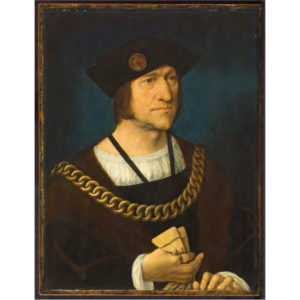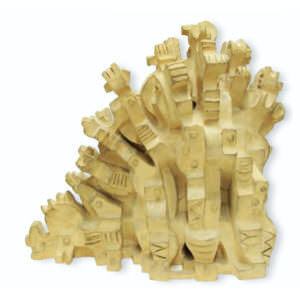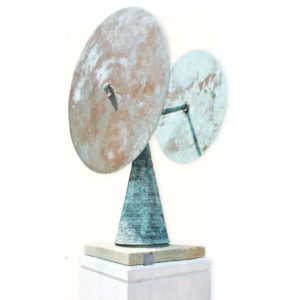The AAM (and the LV) are Linked to a Global Art World
A recent exhibition at the Art Museum not only exemplifies AAM’s global perspective and significance but also spotlights the Lehigh Valley’s connection to the larger art world through the Museum. After a two-year research and evaluation process, the AAM was chosen to be one of eight partner museums around the state to participate in a collection sharing and exhibition development program with the Philadelphia Museum of Art.
This groundbreaking initiative—funded by Art Bridges and the Terra Foundation for American Art—is designed to increase access to American art by sharing treasures from renowned collections with communities across Pennsylvania. The AAM’s inclusion in the program, as well as the works it regularly lends to art institutions throughout the United States, Europe, and Latin America, are evidence of the significance of your art museum and its collection both at home and abroad.
Art as Bridge to the World
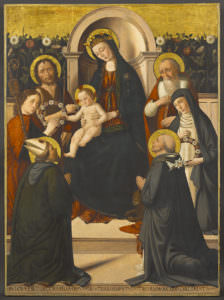
Biagio d’Antonio Tucci (Italian, 1446-1516), Madonna and Child with Saints, ca. 1490, tempera and gold leaf on pane. Allentown Art Museum: Samuel H. Kress Collection, 1960. (1960.15)
While the Museum has received loans from the Philadelphia Museum of Art in the past, the Art Bridges program provides financial support so this type of sharing can happen on a more regular basis. The program also fosters creative collaboration between the two institutions and connects the Lehigh Valley to the greater Philadelphia area through this cultural exchange.
The exhibition—Evolution of the Spiritual: Europe to America (open until September 6, 2020)—features European Renaissance art from the AAM’s Kress Collection, Spanish Colonial art of Latin America from the Philadelphia Museum of Art, and twentieth-century U.S. art from both institutions to expand the idea of what comprises American art.
“We wanted to challenge the conventional definition of American art and explore its diversity by showing the progression of a single subject, in this case the Virgin Mary, through the influences of different cultures,” says Elaine Mehalakes, the AAM’s vice president of curatorial affairs and curator of the exhibition.
“The Allentown exhibit has blended and reinterpreted ideas coming from Europe to the Americas to reveal how everything is connected,” according to Josephine Shea, curatorial coordinator of the Art Bridges + Terra Foundation Initiative with the Philadelphia Museum of Art.
“The installation explores American art in a global context, making visible these connections and showing how they continue into the contemporary movement.”
–Josephine Shea, Curatorial Coordinator of the Art Bridges + Terra Foundation Initiative, Philadelphia Museum of Art
Shea characterizes the Allentown Art Museum as a “top-level museum” and a “very impressive partner.”
“By looking at American art more broadly, we’ll be able to see how the complex influences of trade, migration, immigration, and cultural exchanges over hundreds of years and around the world have shaped American experiences,” says Mehalakes. “It’s an artificial construct to think of the art of our country separately from all the history and cultures that have come before, or even to think of it as a simple progression from Europe to the United States,” she adds.
The exhibition aims to make audiences think about how our country and our community is intertwined with that larger history. “It really opens your eyes to the fact that we are not an isolated culture,” Mehalakes says, “and makes us more aware of the influences on today’s works of art.”
Evolution of the Spiritual: Europe to America features loans from the Philadelphia Museum of Art and was made possible by generous support of art donors at each museum and by the Art Bridges and Terra Foundation for American Art collection-sharing initiative.
![]()
Acquiring New Perspectives
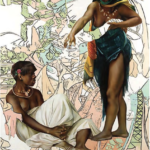
Angela Fraleigh (American, b. 1976), And then we’ll walk right up to the sun, 2016, oil, acrylic, marker, canvas. Courtesy of the artist. Allentown Art Museum: Purchase. Priscilla Payne Hurd Endowment Fund, 2019. (2019.11)
Likewise, the Museum’s active acquisitions program highlights its commitment to introducing globally focused, innovative, and compelling art to our audiences. Take for example one recent acquisition, Angela Fraleigh’s And then we’ll walk right up to the sun, 2016, made of oil, acrylic, and marker on canvas.
Fraleigh has a studio in Allentown and is the chairperson of the Moravian College art department, but her work has garnered attention beyond the Lehigh Valley, including solo exhibitions in New York State, Houston, and Philadelphia. The acquisition of And then we’ll walk right up to the sun furthers the Museum’s goals of fostering the local arts community while also collecting works that participate in dialogues on issues engaging the national and international art world today.
Fraleigh painted the two women in this work after figures by French artist Jean-Leon Gerome (1824-1904), who was known for imagery that affirmed Western fantasies of the Middle East as a place of sensuality, violence, and submissiveness. In doing so, Fraleigh retrieves such women from the sidelines of respected historic works, giving them new life in her monumental paintings. Her works center these characters as the heroes of the story.
The background of And then we’ll walk right up to the sun quotes from ukiyo-e prints by the Japanese artist Kitagawa Utamaro (1753-1806). In Fraleigh’s eyes, Utamaro’s depictions of women raising silkworms or socializing in the pleasure districts of Edo evoke a space of all-female community, power, and possible insurrection. The incorporation of these prints creates a dreamlike, otherworldly setting for the figures, encouraging viewers to be curious about how these women ended up here and ask questions that will lead them to better understand Fraleigh’s intent.
In its combination of realism and the stylized ukiyo-e aesthetic, Fraleigh’s painting advocates different modes of viewing the world, paralleling the Museum’s goal of encouraging visitors to consider new perspectives. When it goes on display, And then we’ll walk right up to the sun will engage stylistically with earlier works in the American collection, encouraging new and critical understandings of these paintings from a contemporary point of view. The feminist and anticolonial messages behind this work can also be connected to other artists in the collection, such as Joan Snyder, Yinka Shonibare, Faith Ringgold, or Wendy Red Star.
AAM around the World
Finally, the importance of the AAM in the larger art world is regularly underscored by the quality and quantity of works loaned to be featured in significant exhibitions around the world.
“The Allentown Art Museum has a global footprint,” says Mehalakes, “which is possible because of the inimitable works of art we have to share with other institutions as a result of our donors’ generosity.”
Referring to the recent Bernard van Orley loan to the BOZAR in Belgium, Mehalakes says that when the Museum loans out a piece of art from its own collections, she’s “struck by seeing it in the context of a major exhibition of that artist’s masterpieces from all over the world.”
“And when the artwork comes back home, we want to celebrate its return by highlighting it in the gallery,” Mehalakes continues. “We want our members to take a look at it with fresh eyes knowing that it has received scholarly and popular attention elsewhere.”
Recent loans from the Allentown Art Museum Collection
Bernard Van Orley (Flemish, ca. 1488-1541), Portrait of a Gentleman, ca. 1520, oil on panel. Samuel H. Kress Collection, 1961. Appeared in Bernard van Orley: Brussels and the Renaissance at BOZAR, Centre for the Arts, Brussels, Belgium.
John Baldessari (American, born 1931), Size/Shape (Destiny), 1988/89, gelatin silver print and acrylic paint. Gift of John and Fannie Saeger, 1989. Appeared in Learning to Read with John Baldessari at Museo Jumex, Mexico City, Mexico.
Peter Grippe (American, 1912-2002), Man with Hammer, 1941, terracotta. The Grippe Collection, 2009. Appeared in Leap Before You Look. Black Mountain College, 1933-1957 at the Institute of Contemporary Art, Boston, MA; the Armand Hammer Museum, Los Angeles, CA; and the Museum of Fine Arts, Houston, Texas.
Lorenzo Lotto (Venetian, c. 1480-1556), Saint Jerome in the Wilderness, 1515, oil on canvas. Samuel H. Kress Collection, 1960. Appeared in Bergamo in the Renaissance Seen through the Eyes of Marcantonio Michiel at the Adriano Bernareggi Museum, Bergamo, Italy.
Harry Bertoia (American, 1915-1978). Double Branched Gongs, 1970/71, bronze sheet and welded bronze. Gift of Audrey and Bernard Berman, 1982. Appearing in Harry Bertoia· Sculpting Mid-Century Modern Life at the Nasher Sculpture Center, Dallas, Texas
Featured image: Marsden Hartley (American. 1877-1943). Blessing the Melon (The Indians Bring the Harvest to Christian Mary for Her Blessing), c. 1918, oil on paperboard. Philadelphia Museum of Art: The Alfred Stieglitz Collection, 1949. (1949–18-13)
This article originally ran in the winter 2019 issue of Synergy Magazine, the magazine for Museum members. Become a Museum member today.


